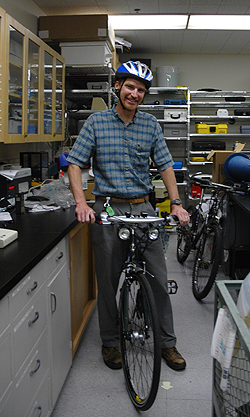Berkeleyan
 Conventional pavement used in roads and parking lots plays a major role in transporting contaminants to nearby waters and eroding streambeds and riverbanks. When the parking lot outside Wellman Hall (above) was revamped recently, its asphalt was replaced with decorative pavers that make the area into a multi-use space. The joints between the pavers are water-pervious, allowing rainwater to percolate slowly into the ground (which acts as a filter) rather than run off directly into Strawberry Creek. (Photo courtesy Capital Projects) |
Are we living within our means?
The campus's first comprehensive sustainability assessment reflects a growing 'green' consciousness - and provides Berkeley with a roadmap for future progress
![]()
| 20 October 2005
Sustainability events Green Room
For information on campus sustainability efforts, visit sustainability.berkeley.edu or e-mail cacs@nature.berkeley.edu. |
These environmentally conscious transportation options have counterparts in many aspects of campus life, from electricity usage to dining-hall practices and the design of new buildings, as the concept of "sustainability" - living in a way that meets current needs without compromising the ecosystems that support our (or future generations') ability to survive - gains traction and adherents.
Next week, sustainability will be in focus, as Berkeley participants join a national forum on campus-based sustainability initiatives and curriculum development (featuring webcast segments from five recent national conferences bearing on the subject) and student activists debut a residence-hall "Green Room" designed to educate undergrads (at a stage when they're developing habits of a lifetime) about products, devices, and behaviors that are kinder to the environment. (For details on these events, see "Sustainability events" at right.)
Nascent "greening" efforts can be found not only in student circles but in campus policy and planning documents, business-operations plans, facilities-management practices, the content of numerous academic courses, and faculty research on energy alternatives, building systems, natural resources, and other key issues. The Chancellor's Advisory Committee on Sustainability (CACS) serves as a hub of discourse and action on the subject, while its recently completed Campus Sustainability Assessment is a cornerstone achievement that will help guide many future efforts.
GRAPHICS
. UC Berkeley Hazardous Chemical Waste 2003-04
. Recycled Materials in 2003-04 by Weight . Distribution of Water Use 2003 |
"There were quite a few surprises," says CACS chair Sasha Gennet, a doctoral student in restoration ecology. "It's wonderful to see the ways in which the campus has already done a lot of greening projects. It showed us that the assessment is timely, that the campus is ready to really engage to make sustainability a strong part of the planning process."
 Tim Pine of Environment, Health, and Safety shows off the Novara Fusion commuter bike that EH&S staff can now use for campus business. The "Cal Clean Fleet" was one of six projects funded this year by CACS's Green Campus Fund.(Deborah Stalford photo) |
The assessment also describes numerous challenges - including older, resource-inefficient buildings, insufficient funds to maintain and upgrade their systems, and funding mechanisms that do not factor in the cost of operating buildings over their life cycle (and thus the long-term operational savings to be gained by using energy-efficient technologies).
Lisa Bauer, manager of Campus Recycling and Refuse Services, calls the assessment "an interesting and rather aggressive step. We took a snapshot of our environmental sustainability right now, so we can identify the low-hanging fruit, which things we need more funding for, which things are still 10 years down the road but should be on our radar - and outline how we're going to move forward."
CACS plans to focus initially on energy-saving opportunities identified by the assessment, in part by hiring student interns to raise energy-conservation consciousness in several of the campus's larger buildings.

